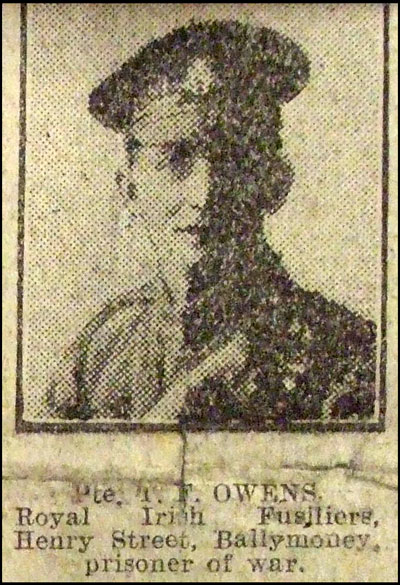Private Thomas Francis Owens

Thomas Francis Owens was born on 13 February 1893 at 36 Crocus Street, Belfast, the first of eight children of printer-compositor Patrick John Owens and his wife Louisa (nee Rainey). By the time of the 1911 Census he was living with his parents and three of his siblings at Meetinghouse Street, Ballymoney, and working as a rural postman. Soon after, they moved to nearby Henry Street.
Owens enlisted in the North Irish Horse at Antrim on 10 May 1915 (No.1525). He embarked for France with E Squadron on 11 January the following year.
On 7 September 1916 the Ballymoney Free Press reported that:
Sergeant John R. Owens, Royal Irish Rifles, arrived home on Wednesday last. He contracted rheumatic fever in the trenches, from which he has recovered. ... In France he met Troopers Thomas Porter, Hugh Lusk, Michael Olpherts, Samuel McAllister, Thomas F. Owens, and Corporal Hodges, of the North Irish Horse.
On 3 July, while E Squadron (by then part of the 1st North Irish Horse Regiment) was at Pas, Owens broke his left arm. He was evacuated to England, via No.16 General Hospital at Le Treport, and was admitted to the Princess Club Hospital, Bermondsey. He then returned to the North Irish Horse Reserve Depot at Antrim.
Following treatment for an illness in the Belfast Hospital and Dublin's Portabello Military Hospital, on 24 April 1917 Owens once again embarked for France, where he was posted to B or C Squadron of the 2nd North Irish Horse Regiment, joining it at Boeschepe in early June. He may have seen action with the regiment in the Battle of Messines later that month.
In August 1917 orders came that the 2nd NIH Regiment would be disbanded and its men transferred to the infantry. Owens was one of 70 men given the job of conducting the regiment's horses to Egypt. They embarked from Marseilles on board HMT Bohemian on 25 August. After a month at Alexandria they returned to France, via Italy. On 5 October 1917 they arrived at the 36th (Ulster) Division Infantry Base Depot at Harfleur for infantry training. After just a few days they were posted to the 9th (Service) Battalion, Royal Irish Fusiliers – renamed the 9th (North Irish Horse) Battalion – joining it in the field at Ruyaulcourt on 12 October. Owens was issued regimental number 41594 and posted to D Company.
Further illness kept Owens in hospital in France from 24 October until the new year. He finally rejoined the 9th (NIH) Battalion on 17 March 1918, just four days before the Germans opened their spring offensive. Owens was one of the many posted as missing following the battalion's fighting withdrawal from St Quentin to near Amiens from 21 to 28 March. It was later learned that he had been captured, unwounded, on 27 March at Erches, near Roye.
Later that year the Ballymoney Free Press reported:
To Mrs. T. Owens, Henry Street, belongs the honour of having four sons serving. Sergeant John Owens is with the Royal Irish Rifles; Private Thomas Owens is with the Royal Irish Fusiliers, and was wounded in France when serving with the N.I.H.; Cadet Joseph Owens and Private Michael Owens are attached to the Royal Air Force. There is only another son at home, and he is much under military age. A characteristic letter has been received by his mother from Private Michael Owens stating that "he is only doing his duty for a certain class who could join up at home."
Owens remained a prisoner until the end of the war, held at camps in Giessen and Limburg. He was released soon after the Armistice, arriving in Dover on 6 December 1918.
On 8 April 1919 Owens was demobilised and transferred to Class Z, Army Reserve. His character was recorded as 'very good'.
After the war Owens returned to Ballymoney and to his work as a postman. On 12 April 1921 he married Sarah Violet Smyth at the Ballymoney Roman Catholic Church.
Image from the Belfast Evening Telegraph kindly provided by Nigel Henderson, Researcher at History Hub Ulster (www.greatwarbelfastclippings.com).
